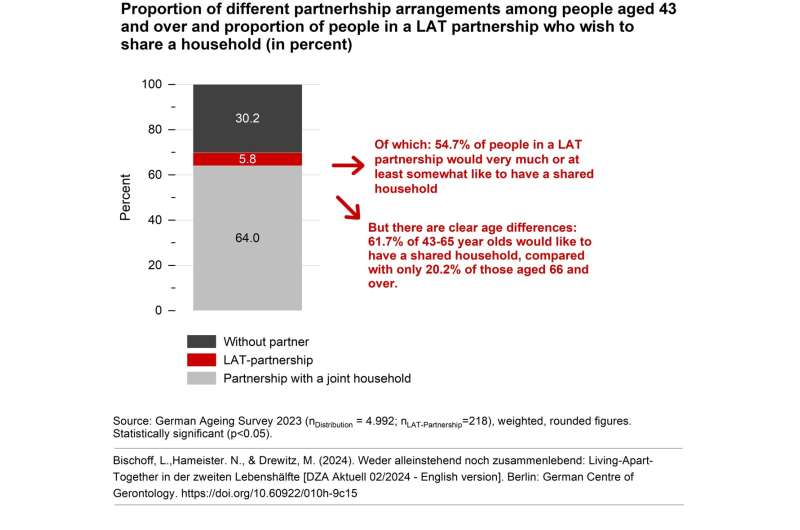This article has been reviewed according to Science X's editorial process and policies. Editors have highlighted the following attributes while ensuring the content's credibility:
fact-checked
proofread
Living apart in the second half of life—a necessary evil or a chosen lifestyle?

Official statistics only reflect institutional partnership status, meaning that people who live alone in their home are considered to be partnerless. However, if we look at social status, we see that a growing number of people are living in a partnership but in two households of their own. This is referred to as "living-apart-together" (LAT for short).
It is important to investigate this group of people in more detail in order to understand in which respects they are similar to couples living together, for example in terms of a reduced risk of loneliness or a greater sense of well-being, or to people without partners, for example with regard to poverty risks and housing cost burdens.
Just under 6% of the German Aging Survey respondents state that they live in a LAT partnership. But is this living arrangement self-chosen, is it the result of professional and/or private commitments in different locations, for example, or is it a precursor to moving in together?
The researchers approached this aspect by asking the question "And regardless of your circumstances, how much would you like to live in a shared household with your current (married) partner?"
In the entire group of people aged 43 and over, more than half (54.7%) stated that they would like to live in a shared household with their partner. However, there are clear differences according to age: While over 60% of 43- to 65-year-olds would like to live together, only 1in 5 people aged 66 and over (61.7% vs. 20.2%).
This could be due to the fact that older people have lived in their neighborhood for longer and therefore do not want to move, or have already become accustomed to living alone.
"We also looked at differences between women and men, although these are not statistically significant. However, the distributions reflect the results of previous studies that men are more likely to want a partner with whom they live in a shared household and women are more likely to want a partner with whom they can spend their free time, but for whom they do not have to provide in a shared household," explained Luisa Bischoff, first author of the report.
The study also took into account the distribution of partnership living arrangements in general and the differences according to income level and level of education.
More information: Luisa Bischoff et al, Neither single nor living together, German Centre of Gerontology (2024). DOI: 10.60922/010h-9c15
Provided by Deutsches Zentrum für Altersfragen





















